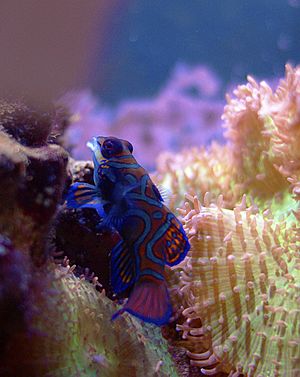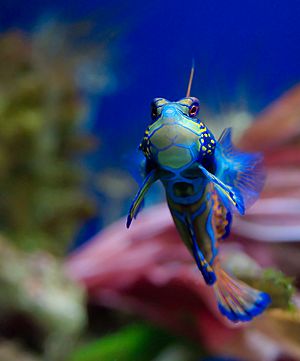Mandarinfish facts for kids
Quick facts for kids Mandarinfish |
|
|---|---|
 |
|
| Conservation status | |
| Scientific classification | |
| Synonyms | |
|
The Synchiropus splendidus, also known as the mandarinfish or mandarin dragonet, is a small, very colorful fish. It belongs to the dragonet family. This fish is quite popular with people who have saltwater aquariums. Mandarinfish live in the Pacific Ocean, from the Ryūkyū Islands down to Australia. They usually prefer warmer waters.
Contents
Discovering the Mandarinfish
The mandarinfish was first described in 1927 by Albert William Herre. He was an American fish scientist working in the Philippines. He first named it Callionymus splendidus. Later, it was moved to the group called Synchiropus.
What Does the Name Mean?
The name Synchiropus comes from Ancient Greek words. "Syn-" means "together," and "-chiropus" means "hand-foot." The word splendidus comes from Latin and means "bright" or "glittering." This fits the fish perfectly!
The common name "mandarinfish" comes from its amazing, bright colors. These colors look a lot like the fancy robes worn by old Imperial Chinese officials called mandarins.
Other Names for This Fish
People also call this fish by other names. These include mandarin goby, green mandarin, striped mandarinfish, striped dragonet, and sometimes psychedelic mandarinfish. It's important not to confuse it with the Chinese perch (Siniperca chuatsi). That fish is also called a mandarin fish, but it's not closely related.
The mandarinfish is part of a large group of fish called the Callionymidae family. This family has over 182 different kinds of dragonets. The Synchiropus group has 51 types of fish. The mandarinfish is in a smaller group within Synchiropus called Pterosynchiropus. Other fish in this smaller group include S. occidentalis and the psychedelic mandarin (S. picturatus).
Amazing Appearance and Habitat
The mandarinfish is one of only two animals with a backbone that is truly blue because of special cells. These cells are called "cyanophores." In most other animals, blue color comes from how light bounces off tiny structures. But the mandarinfish has actual blue pigment in its cells!
Colors and Body Shape
The mandarinfish has a body shape similar to a goby, but that's where the likeness ends. Its colors are incredibly bright. It has a vivid blue background with swirly orange stripes. Its face is blue-green with bold blue stripes.
The fish uses its large pelvic fins to "walk" along the seafloor. People sometimes mistake these for its pectoral fins. The real pectoral fins are almost clear and are near the middle of its body. The anal fins and part of the tail are also striped in bright orange and blue. The dorsal fin, which is very tall in males, has a striking orange and blue pattern. Its eyes are usually red with black centers.
Different Color Types
There are different color types of mandarinfish. The "green mandarin" is the one most often described. The "red mandarin" is the same species, but its pelvic fins and what would be orange are red. Sometimes, the whole fish can even be red with black stripes. The "spotted mandarin" is light gray-green with black, pink, and blue spots.
Where Mandarinfish Live
Mandarinfish live in coral reefs. They like calm lagoons and reefs close to the shore. They move slowly and are common in their home areas. However, they are hard to spot because they stay near the bottom and are small. They only grow to about 6 centimeters (about 2.4 inches) long.
What Mandarinfish Eat
Mandarinfish mainly eat small crustaceans and other tiny invertebrates. Scientists have studied what wild mandarinfish eat. They found that these fish eat many different things. Their diet includes tiny copepods, worms, small snails, and even fish eggs.
In the wild, mandarinfish eat all day long. They carefully pick out small prey from the coral and rocks. They have a specific area where they search for food.
Mandarinfish and People
Mandarinfish are very popular in the aquarium trade. However, they can be hard to keep as pets. This is because they have very specific eating habits. Some mandarinfish never get used to eating aquarium food. They will only eat live amphipods and copepods, just like in the wild. But if they do learn to eat other foods, they can be quite strong and healthy. They are also very good at fighting off diseases like "marine ich."
Mandarinfish are less likely to get marine ich because their skin is different. They don't have typical scales. Instead, they have a layer of slimy, bitter stuff. This slime helps protect them from diseases. It also probably makes predators not want to eat them. Their bright colors might even warn predators that they taste bad!
The mandarinfish has even appeared on postage stamps! It was on a 39-kip stamp from Laos in 1987. It also appeared on a 40-cent stamp from the Federated States of Micronesia in 1993.
- Froese, Rainer and Pauly, Daniel, eds. (2005). "Synchiropus splendidus" in FishBase. 10 2005 version.
- Caresheet at the Aquarium Wiki




